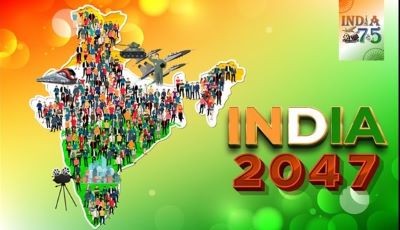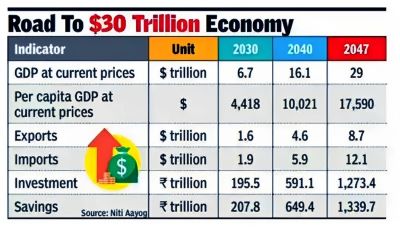Context
Viksit Bharat, India's ambitious endeavor to become a developed nation by its centenary Independence year in 2047, has been formally launched. While the pursuit of economic development takes center stage in this vision, questions arise about the comprehensive nature of development and its alignment with the diverse aspirations of the Indian populace. Critics argue that the current model of development, heavily emphasizing economic growth, reflects a Euro-centric perspective that may not entirely serve India's best interests.
|
What is Vision India@2047? Vision India@2047 is an initiative spearheaded by NITI Aayog, India's premier policy think tank, with the goal of formulating a comprehensive roadmap for the nation's progress over the next 25 years. The overarching objective is to position India as a global leader in innovation, technology, human development, and environmental sustainability. Key Objectives: 1. Attaining a robust USD 30 trillion economy, accompanied by a per-capita income ranging from USD 18,000 to USD 20,000, bolstered by strong public finances and a resilient financial sector. 2. Establishing world-class infrastructure in both rural and urban areas to enhance the overall quality of life. 3. Streamlining government intervention in citizens' lives, fostering a digital economy, and promoting digital governance. 4. Creating 3-4 global champions in various sectors through mergers or restructuring, while bolstering indigenous industry and innovation. 5. Achieving self-reliance in defense and space sectors, elevating India's global standing. 6. Prioritizing green growth and climate action by expanding renewable energy capacity and curbing carbon emissions. 7. Empowering the youth through education and skill development, thereby generating more employment opportunities. 8. Collaborating with foreign research and development organizations to establish top-tier labs within the country and securing positions for at least 10 Indian institutions among the top 100 globally. Roadmap |
The Comprehensive Development Agenda:
Viksit Bharat encompasses various aspects, including structural transformation, labor market organization, competitiveness enhancement, financial and social inclusion improvement, governance reforms, and capitalizing on opportunities in the Green Revolution. While these factors contribute to material development, the question arises whether economic prosperity alone can fulfill India's multifaceted aspirations by 2047. Critics of conventional development models stress the need for a reimagined approach that incorporates broader dimensions of well-being and happiness.
Redefining the Narrative: From Viksit Bharat to Khushhal Bharat-Viksit Bharat
A paradigm shift is proposed, advocating for a transition from 'Viksit Bharat' to 'Happy India-Developed India' (Khushhal Bharat-Viksit Bharat). Happiness is posited as the central pursuit in India's developmental journey, arguing that without achieving happiness, development holds little meaning. The critique extends to the observation that nations labeled as developed often exhibit poor happiness markers, neglecting social and psychological well-being indicators. A pressing concern is India's rank of 126 out of 137 countries in the World Happiness Report 2023, despite being the fifth-largest economy.
The Happiness Index and Its Parameters:
Happiness, once considered subjective, has now become a measurable goal in public policy worldwide. The World Happiness Report, introduced in 2012, employs a robust methodology, incorporating six variables:
1. GDP per capita,
2. healthy life expectancy at birth,
3. generosity,
4. social support,
5. freedom to make life choices, and
6. perception of corruption.
The 2023 report emphasizes trust and benevolence, especially in crisis situations like the COVID-19 pandemic.
Social Connections and Kindness:
The report underscores the role of social connections and relationships in contributing to happiness and well-being. Acts of kindness, such as helping strangers, donating to charity, and volunteering, have increased globally despite the challenges posed by the pandemic. Countries like Finland, Denmark, Iceland, and the Netherlands, deemed the happiest, have achieved development without sacrificing social cohesion. This prompts the question of whether a happiness-induced development model is pertinent for India, given its strong reliance on social relationships and cultural values.
Beyond GDP: Comprehensive Indices for Development:
Critics argue that the current development model's exclusive focus on GDP fails to consider crucial human and social aspects. Advocates for a more inclusive approach suggest incorporating indices such as the Human Development Index (HDI), which considers life expectancy, educational attainment, and income levels. Additionally, the United Nations Research Institute for Social Development's Social Development Index, created in 1970, provides 16 core indicators that could enhance the comprehensiveness of Viksit Bharat.
Various international indices developed by organizations like the World Bank offer alternative perspectives on development. The Environmentally Sustainable Development Division's 'Green Index' measures a nation's wealth by considering produced assets, natural resources, and human resources. An 'International Human Suffering Index' also evaluates countries based on different parameters of human suffering. These indices, when integrated into the vision for Viksit Bharat@2047, could provide a more holistic understanding of development.
Incorporating Comprehensive Indices:
The European Commission's shift from GDP to a measurement of economic performance and social progress aligns with the need for a more comprehensive approach. Specific indices like the Global Innovation Index, Rule of Law Index, Poverty Index, Corruption Perceptions Index, Gender Equality Index, and World Press Freedom Index are proposed for inclusion in Viksit Bharat's development agenda. By considering these diverse indices, India can strive towards not just economic prosperity but a well-rounded and inclusive development that fosters happiness among its citizens.
Conclusion:
As India embarks on the Viksit Bharat odyssey, the imperative to reassess its development priorities becomes evident. Shifting the focus from a narrow economic perspective to a more comprehensive model that prioritizes happiness is proposed. The Happiness Index, with its well-defined parameters, offers a valuable framework for measuring success beyond GDP. Social connections, acts of kindness, and a focus on well-being can reshape the narrative of development.
Incorporating a variety of indices, from the Human Development Index to the World Press Freedom Index, can provide a nuanced understanding of development. By acknowledging the importance of social and cultural factors, India has the opportunity to redefine its development trajectory. Ultimately, the vision for Viksit Bharat@2047 should not just be about economic growth but about creating a Happy India that embraces holistic well-being and societal flourishing.
|
Probable Questions for UPSC Mains Exam
|
Source – The Hindu









